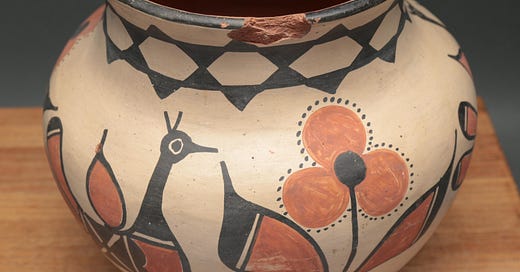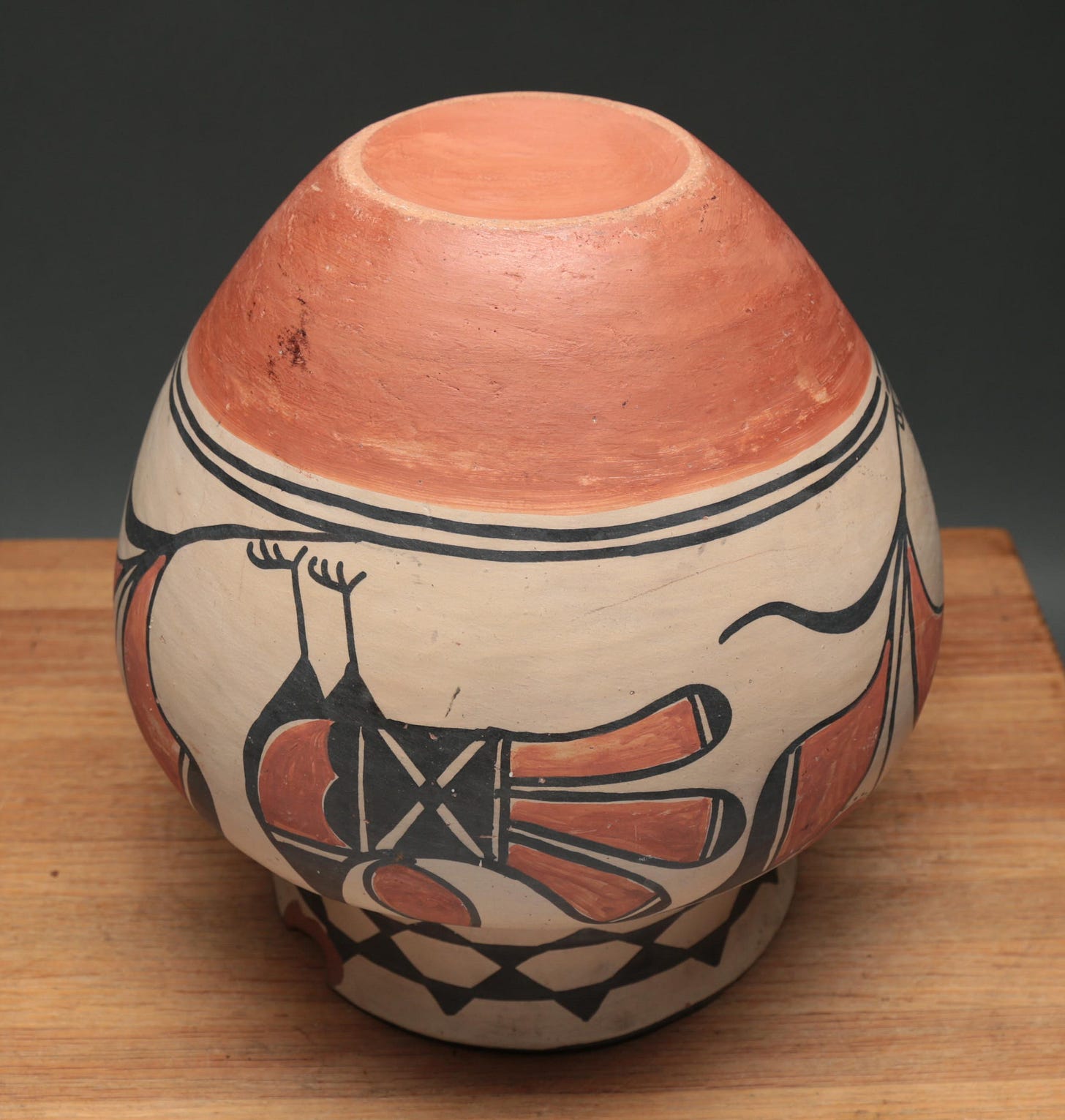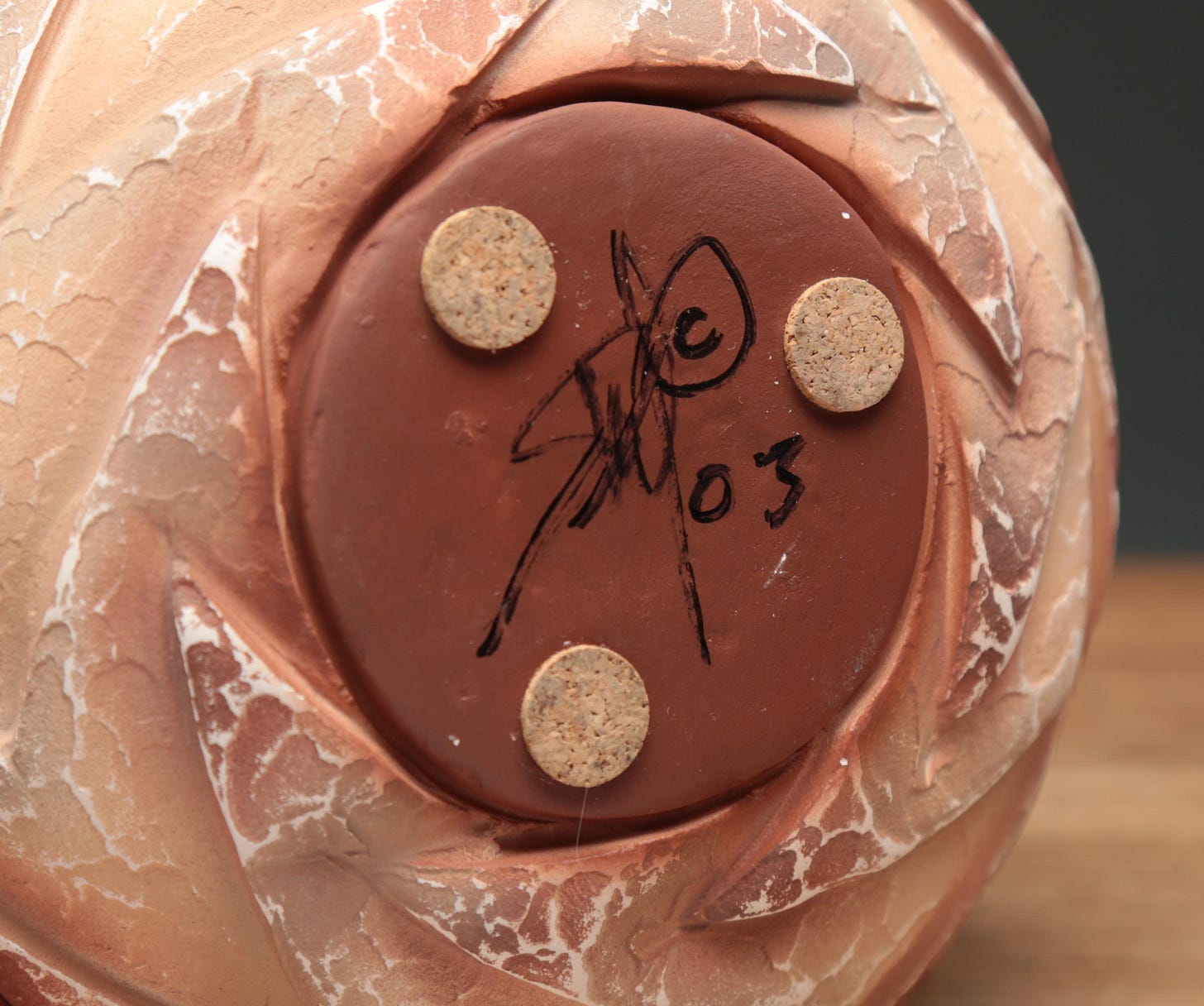WE are going to have a “Western” auction coming up soon. How that differs from a “Southwestern” auction (our usual fare) is beyond me.
The thing that I enjoy about W/SW auctions is, the pottery.
This pot has many of the decorative characteristics of the Santa Domingo Pueblo, AKA, Kewa Santa Domingo. The color-scheme is known as “polychromatic”. The colors come from clay slip, colored with different elements.
Flora and fauna design elements are also common with Santa Domingo potters, specifically, the interspersing of birds and flowers, along with geometric patterns featuring triangles. You will notice that the bottom of the pot, and the interior of the neck, are smooth, burnished with a smooth stone.
It’s the bottom of the pot that I want to draw your attention to. You’ll notice that there is a very consistent, smooth, concave depression on the bottom of this pot. This feature, along with the relatively thin wall and the lack of finger impressions on the inside of the pot, leads one to believe that this pot was made after WWII. This pot might be as early as the late 40’s. Before that, most pottery of this size, from this region, was made by pressing clay by hand. Also, the foot of this pot shows a marked difference from earlier pots, in that the convex depression was made with a tool, while the pot sat spinning on a wheel. It was nicely done, too.
History That You Can Hold
I have mentioned before that I enjoy the history of the objects that pass across my desk, but sometimes the history is more personal. This pot was made well over 100 years ago, most likely at the Zia Pueblo, in New Mexico. This pot was not thrown on a wheel. It was probably made by a woman and fired in a wood fired kiln, if a kiln was used at all. The d…
You will notice that the pot referenced in this earlier posting carries certain stylistic differences from the pot shown above. If you open the article and read through the text, you’ll see that I mention the finger grooves of the potter, present on the inside. It sends a thrill right through me when I can put my fingers into the same grooves as the potter who made this pot, over 100 years ago.
This earlier pot, comes from the Zia Pueblo. While it also carries a polychromatic color scheme, typical of the region, you will see that the designs are different. The iconography used was typical of many of the Kewas, but put together in distinctive ways. Many potters had patterns and designs that were almost trademarks, while it was not common for potters to sign their pots, the knowledgeable collector can look at a pot and know who the potter was simply through the decorations. Sadly, I am not that knowledgeable.
This pot is more modern. It was thrown on a wheel, and moderne metal tools were used to carve the detail. I don’t think that this design was created mechanically, I believe that it was carved by hand, but, holy cow! The skill required to cut this pattern by hand, with such precision, boggles my mind. There is also another feature that makes me think that this is a modern pot…
The potter signed the bottom! That makes it SO much easier to date, and to provide attribution for the potter.
The first two pots were practical, made and used for a purpose. This third pot is strictly for decoration; it’s too small for household use. Regardless, I dig these pots. I thrown myself, and I am always looking to improve. One day, I hope to equal the skills of potters who dies long before I was born, and who used only their hands to create their art.









Pottery is such a fascinating art form. This was a great sliver of knowledge on the subject — thanks Darin
.. am a total lover of Indigenous culture art craft legend performance ritual than ‘any other culture.. it’s not even close.. & pottery / motif / iconology .. the ‘mystical worlds & methinks ‘pottery especially & ‘drum circles.. Canada’s west coast totem imagery & ‘style .. not to mention the boldness & colour & ‘dynamism.. Am very into ‘iconic .. & your examples are so classic as well..
Since Navajo is my American Indian fave culture & society.. hardly surprising I’d bring the two ‘nations together in my fiction writing.. & thus the ‘pueblo pottery is just what I needed today thanks !
will drop you a note in this regard - mebbe in the AM tomorrow.. ‘think - shamanism ! 🦎🏴☠️